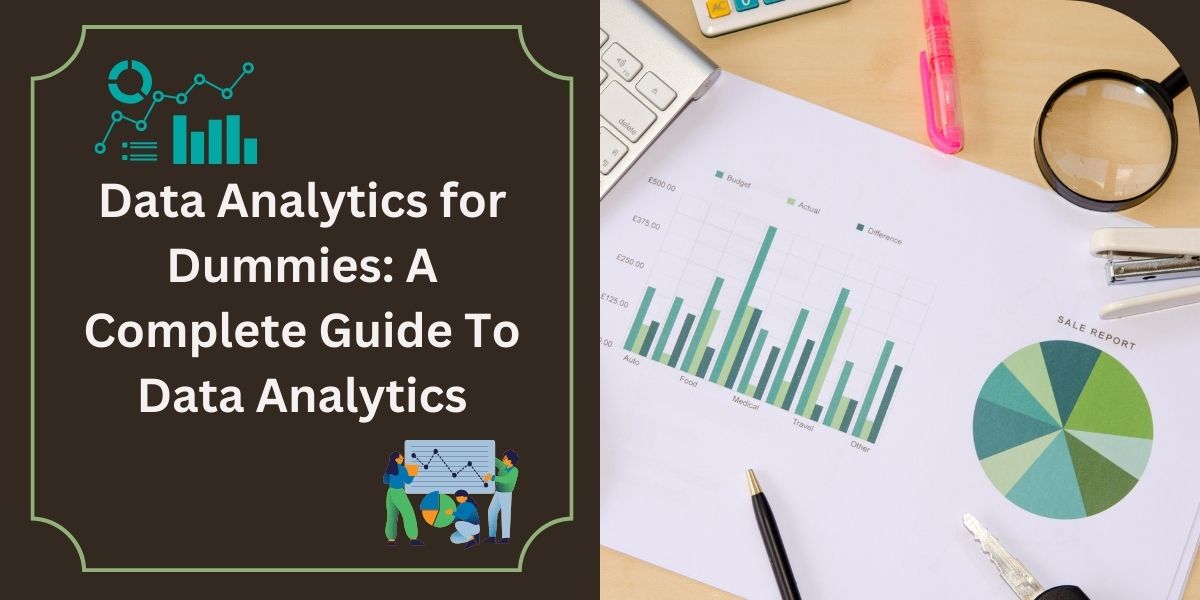Data analytics is like being a detective for data, turning raw information into stories and insights. So, even if you feel like a “dummy” about data right now, fear not! With this guide, Data Analytics for Dummies, you can unlock the secrets hidden in the numbers.
Imagine you have a giant box of puzzle pieces, and you’re trying to make sense of the picture they create. That’s a bit like what data analytics does with information. It’s about finding patterns, telling stories, and discovering valuable insights from a sea of numbers.
Data Analytics for Dummies is a user-friendly guide designed for individuals who are new to the field of data analytics. In this article, you’ll learn the fundamental concepts, techniques, and tools used in the analysis of data.
What is data analytics?
Most companies are collecting loads of data all the time—but, in its raw form, this data doesn’t really mean anything. This is where data analytics come in.
Data analytics is the process of analyzing raw data in order to draw out meaningful, actionable insights, which are then used to inform and drive smart business decisions.
A data analyst will extract raw data, organize it, and then analyze it, transforming it from incomprehensible numbers into coherent, intelligible information. Having interpreted the data, the data analyst will then pass on their findings in the form of suggestions or recommendations about what the company’s next steps should be.
You can think of data analytics as a form of business intelligence, used to solve specific problems and challenges within an organization.
It’s all about finding patterns in a dataset that can tell you something useful and relevant about a particular area of the business—how certain customer groups behave, for example, or how employees engage with a particular tool.
Data analytics help you make sense of the past and predict future trends and behaviors. Rather than basing your decisions and strategies on guesswork, you’re making informed choices based on what the data is telling you.
What Are the Different Types of Data Analysis?
In this guide, Data Analytics for Dummies, we now have a working definition of data analytics, so let’s explore the four main types of data analysis: descriptive, diagnostic, predictive, and prescriptive.
Descriptive analytics
Descriptive analytics is a simple, surface-level type of analysis that looks at what has happened in the past. The two main techniques used in descriptive analytics are data aggregation and data mining.
So, the data analyst first gathers the data and presents it in a summarized format (that’s the aggregation part) and then “mines” the data to discover patterns.
The data is then presented in a way that a broad audience (not just data experts) can understand.
Its also important to highlight that descriptive analytics does not attempt to explain past data or create cause-and-effect correlations; at this point, it is simply a matter of determining and describing the “what.”
Diagnostic analytics
While descriptive analytics looks at the “what,” diagnostic analytics explores the “why.” When running diagnostic analytics, data analysts will first seek to identify anomalies within the data—that is, anything that the data in front of them cannot explain.
For example, if the data shows that there was a sudden drop in sales for the month of March, the data analyst will need to investigate the cause.
To do this, they’ll initiate the discovery phase, identifying any additional data sources that might provide more information about why such anomalies arose. Finally, the data analyst will try to uncover causal relationships—for example, by looking at any events that may correlate with or correspond with the decrease in sales.
At this stage, data analysts may use probability theory, regression analysis, filtering, and time-series data analytics.
Predictive analytics
Just as the name suggests, predictive analytics tries to predict what is likely to happen in the future. This is where data analysts start to come up with actionable, data-driven insights that the company can use to inform their next steps.
Predictive analytics estimates the likelihood of a future outcome based on historical data and probability theory, and while it can never be completely accurate, it does eliminate much of the guesswork from key business decisions.
Predictive analytics enables forecasting various outcomes, ranging from identifying the most popular products at a specific time to projecting potential increases or decreases in company revenue within a given period.
Ultimately, businesses use predictive analytics to enhance their chances of “hitting the mark” and taking the most appropriate actions.
Prescriptive analytics
Building on predictive analytics, it advises on the actions and decisions that should be taken.
In other words, prescriptive analytics shows you how you can take advantage of the outcomes that have been predicted. When conducting prescriptive analysis, data analysts will consider a range of possible scenarios and assess the different actions the company might take.
Prescriptive analytics is one of the more complex types of analysis and may involve working with algorithms, machine learning, and computational modeling procedures.
However, the effective use of predictive analytics can have a huge impact on the company’s decision-making process and, ultimately, on the bottom line.
What are the types of data analysts?
Depending on your interests and skill set, you can pursue several types of data analyst roles. In this guide, Data Analytics for Dummies, we will look at some common types of data analysts.
Business/Data Analyst
A business analyst, or data analyst, is responsible for collecting, analyzing, and interpreting complex data sets to help companies make informed decisions.
They work closely with stakeholders to identify business requirements and design supporting data models. They may also develop reports and dashboards to present data insights to decision-makers.
Marketing Analyst
A marketing analyst uses data to help companies understand their customers and develop marketing strategies.
They analyze customer behavior, demographic data, and market trends to help companies effectively target their marketing efforts. They may also build marketing performance metrics to track the success of marketing campaigns.
Financial Analyst
A financial analyst uses data to help companies make financial decisions. They may analyze financial data such as revenue, expenses, and profitability to help companies identify areas for improvement or growth.
They may also develop economic models to forecast future performance and inform strategic planning.
Healthcare Analyst
A healthcare analyst uses data to help healthcare organizations improve patient outcomes and reduce costs. They may analyze healthcare data, such as patient records, clinical trials, and insurance claims, to identify trends and patterns.
They may also develop predictive models to help healthcare providers make more informed decisions.
Data Scientist
A data scientist is responsible for designing and developing complex algorithms and models to solve data-driven problems.
They work with large, complex data sets and use advanced analytical techniques to extract insights and develop predictive models. They may also work with other data analysts to develop data-driven solutions for businesses.
What is the average salary of a data analyst?
In this guide on data analytics for dummies, we will be looking at the average salary of a data analyst.
According to Glassdoor, a data analyst in the United States can earn a minimum salary of $43K to a maximum of $95K per year.
In India, a data analyst can earn an average salary of 500K per year.
The average salary of a data analyst in Australia is around A$83K per year. In the United Kingdom, a data analyst earns an average salary of £30,000 per year.
Data analysts have a lot of scope in today’s times, as companies are on the lookout for professionals who can efficiently and effectively handle their data.
The companies hiring for the position of data analyst are Amazon, Microsoft, Capital One, Walmart, PayPal, Google, Facebook, Twitter, Bloomberg, and Apple, to name a few.
What are the tasks and responsibilities of a data analyst?
As you can see, the role of the data analyst means different things to different companies. However, there are some common threads that you’ll find among most data analyst job descriptions.
Based on real job ads, Data Analytics for Dummies will explore some of the typical tasks and responsibilities of a data analyst.
- Manage the delivery of user satisfaction surveys and report on results using data visualization software
- Work with business line owners to develop requirements, define success metrics, manage and execute analytical projects, and evaluate results
- Monitor practices, processes, and systems to identify opportunities for improvement
- Proactively communicate and collaborate with stakeholders, business units, technical teams, and support teams to define concepts and analyze needs and functional requirements
- Translate important questions into concrete analytical tasks
- Gather new data to answer client questions, collating and organizing data from multiple sources
- Apply analytical techniques and tools to extract and present new insights to clients using reports and/or interactive dashboards
- Relay complex concepts and data into visualizations
- Collaborate with data scientists and other team members to find the best product solutions
- Design, build, test, and maintain backend code
- Establish data processes, define data quality criteria, and implement data quality processes
- Take ownership of the codebase, including suggestions for improvements and refactoring
- Build data validation models and tools to ensure data being recorded is accurate
- Work as part of a team to evaluate and analyze key data that will be used to shape future business strategies
Data Analytics for Dummies: What is the Typical Process a Data Analyst Will Follow?
Now that we’ve set the scene in terms of the overall data analyst role, let’s drill down to the actual process of data analysis. Here, we’ll outline the five main steps that a data analyst will follow when tackling a new project:
1: Define the question(s) you want to answer
The first step is to identify why you are conducting analysis and what question or challenge you hope to solve. At this stage, you’ll take a clearly defined problem and come up with a relevant question or hypothesis you can test. You’ll then need to identify what kinds of data you’ll need and where it will come from.
For example, a potential business problem might be that customers aren’t subscribing to a paid membership after their free trial ends. Your research question could then be, “What strategies can we use to boost customer retention?”
2: Collect the data
With a clear question in mind, you’re ready to start collecting your data. Data analysts will usually gather structured data from primary or internal sources, such as CRM software or email marketing tools.
They may also turn to secondary or external sources, such as open data sources. These include government portals, tools like Google Trends, and data published by major organizations such as UNICEF and the World Health Organization.
3: Clean the data
Once you’ve collected your data, you need to get it ready for analysis—and this means thoroughly cleaning your dataset.
Your original dataset may contain duplicates, anomalies, or missing data that could distort how the data is interpreted, so all of these need to be removed. Data cleaning can be a time-consuming task, but it’s crucial for obtaining accurate results.
4: Analyze the data
Now for the actual analysis! How you analyze the data will depend on the question you’re asking and the kind of data you’re working with, but some common techniques include regression analysis, cluster analysis, and time-series analysis (to name just a few).
5: Visualize and share your findings
This final step in the process is where data is transformed into valuable business insights. Depending on the type of analysis conducted, you’ll present your findings in a way that others can understand—in the form of a chart or graph, for example.
At this stage, you’ll demonstrate what the data analysis tells you in regard to your initial question or business challenge and collaborate with key stakeholders on how to move forward.
This is also a good time to highlight any limitations to your data analysis and to consider what further analysis might be conducted.
What tools and techniques do data analysts use?
Much like web developers, data analysts rely on a range of different tools and techniques. So what are they? This guide, Data Analytics for Dummies, will explain these tools and techniques. Let’s take a look at some of the major ones:
Data analytics techniques
Before we introduce some key data analytics techniques, let’s quickly distinguish between the two different types of data you might work with: quantitative and qualitative.
Quantitative data is essentially anything that is measurable. For example, the number of people who answered “yes” to a particular question on a survey or the number of sales made in a given year Qualitative data, on the other hand, cannot be measured and comprises things like what people say in an interview or the text written as part of an email.
Data analysts will usually work with quantitative data; however, there are some roles out there that will also require you to collect and analyze qualitative data, so it’s good to have an understanding of both. With that in mind, here are some of the most common data analytics techniques:
Regression analysis
This method is used to estimate or “model” the relationship between a set of variables.
You might use this to see if certain variables (a movie star’s number of Instagram followers and how much her last five films grossed on average) can be used to accurately predict another variable (whether or not her next film will be a big hit). Regression analysis is mainly used to make predictions.
Note, however, that on their own, regressions can only be used to determine whether or not there is a relationship between a set of variables—they can’t tell you anything about cause and effect.
Factor analysis
Sometimes known as dimension reduction, this technique helps data analysts uncover the underlying variables that drive people’s behavior and the choices they make.
Ultimately, it condenses the data in many variables into a few “super-variables,” making the data easier to work with. For example, if you have three different variables that represent customer satisfaction, you might use factor analysis to condense these variables into just one all-encompassing customer satisfaction score.
Cohort analysis
A cohort is a group of users who have a certain characteristic in common within a specified time period—for example, all customers who purchased using a mobile device in March may be considered as one distinct cohort.
In cohort analysis, customer data is broken up into smaller groups or cohorts; so, instead of treating all customer data the same, companies can see trends and patterns over time that relate to particular cohorts. By recognizing these patterns, companies are then able to offer a more targeted service.
Cluster analysis
This technique is all about identifying structures within a dataset.
Cluster analysis essentially segments the data into groups that are internally homogenous and externally heterogeneous. In other words, the objects in one cluster must be more similar to each other than they are to the objects in other clusters.
Cluster analysis allows you to observe the distribution of data across a dataset without predefined classes or groupings. In marketing, for instance, it can be utilized to identify distinct target groups within a larger customer base.
Time-series analysis
In simple terms, time-series data is a sequence of data points that measure the same variable at different points in time.
Time-series analysis, then, is the collection of data at specific intervals over a period of time in order to identify trends and cycles. Enabling data analysts to make accurate forecasts for the future.
If you wanted to predict the future demand for a particular product, you might use time-series analysis to see how the demand for this product typically looks at certain points in time.
Data analytics tools
Now let’s take a look at some of the tools that a data analyst might work with.
If you aim to become a data analyst, you must be proficient in at least some of the listed tools. However, if you’ve never heard of them, don’t let that deter you! Like most things, getting to grips with the tools of the trade is all part of the learning curve.
Here are the top ones:
Microsoft Excel
Excel is a software program that enables you to organize, format, and calculate data using formulas within a spreadsheet system.
For decades, this tool has been used by data analysts to run basic queries and to create pivot tables, graphs, and charts. Excel also features a macro-programming language called Visual Basic for Applications (VBA).
Tableau
Tableau is a popular business intelligence and data analytics software that is primarily used as a tool for data visualization.
Data analysts use Tableau to simplify raw data into visual dashboards, worksheets, maps, and charts. This helps to make the data accessible and easy to understand, allowing data analysts to effectively share their insights and recommendations.
SAS
SAS, a command-driven software package, performs advanced statistical analysis and data visualization.
It is widely used in the industry due to its offering of a diverse range of statistical methods and algorithms, customizable options for analysis and output, and the ability to generate publication-quality graphics.
RapidMiner
This is a software package used for data mining (uncovering patterns), text mining, predictive analytics, and machine learning.
Used by both data analysts and data scientists alike, RapidMiner comes with a wide range of features, including data modeling, validation, and automation.
Power BI
Power BI is a business analytics solution that lets you visualize your data and share insights across your organization.
Similar to Tableau, Power BI is primarily used for data visualization. While Tableau is built for data analysts, Power BI is a more general business intelligence tool.
Data Analytics for Dummies: What Skills Do You Need to Become a Data Analyst?
In addition to mastering the tools and techniques covered so far, data analysts are also expected to develop specific skills and abilities. Here are some of the most important hard and soft skills you’ll need to become a data analyst:
Hard skills
Mathematical and statistical ability
Data analysts spend a large portion of their time working with numbers. So it goes without saying that you’ll need a mathematical brain!
Knowledge of programming languages such as SQL, R, or Python
As we’ve seen, data analysts rely on a number of programming languages to carry out their work. This may seem daunting at first, but there’s nothing that can’t be learned over time.
An analytical mindset
It’s not enough to just crunch the numbers and share your findings. Data analysts need to be able to understand what’s going on and to dig deeper if necessary. It’s all in the name—an analytical mindset is a must!
Data visualization
There’s no point in doing all of that analysis if you don’t have an effective way to put those insights together. And communicate them to stakeholders. That’s where data visualization comes in.
Soft skills
Keen problem-solving skills
Data analysts have a wide variety of tools and techniques at their disposal. A key part of the job is knowing what to use and when.
Remember: data analytics is all about answering questions and solving business challenges, and that requires some keen problem-solving skills.
Excellent communication skills
Once you’ve harvested your data, it’s important to share your findings in a way that benefits the business.
Data analysts work in close collaboration with key business stakeholders. They may be responsible for sharing and presenting their insights to the entire company.
So, if you’re thinking about becoming a data analyst, it’s important to make sure that you’re comfortable with this aspect of the job.
Adaptability
You’ve probably gotten a sense of it by now, but the field of data analytics is constantly evolving. This means that it’s vital to keep an open mind and be aware of new technologies and techniques. Try to make your learning a key part of how you work—the benefits will definitely pay off.
Data Analytics for Dummies: Tips For Becoming a Data Analyst
- Get Experience: Most jobs will require some experience in the field. You can gain an edge over the competition by working as an intern first. The hands-on problem-solving and data analysis experience you gain through an internship will be invaluable, even later in your career. Another great way to gain valuable insight into this field is by working with a mentor. Apart from internships and mentors, you can work on small projects. Small projects will reflect well on your portfolio.
- Land A job: Initially, your job profile may be that of a junior data analyst or an entry-level data analyst. With these jobs, you can hone your data-analyzing skills, which will help you progress in your career.
- Keep learning. Getting a job doesn’t mean you’ve reached the end of your learning journey. You should always be eager to learn about new techniques, innovative tools, and strategies. If you want to move ahead in your career, you can take up some additional certification courses. An example is Microsoft Certified Solutions Expert (MCSE). Continuing education helps you gain more knowledge in your field and also reflects in your salary.
What Is the Workplace/Work Environment of a Data Analyst Like?
A data analyst’s workplace and work environment can vary depending on their industry and company. Data analysts may work in a range of settings, including traditional office environments, remote work, or a combination of both.
Data analysts may work independently or as part of a team. They collaborate with other data professionals, such as data scientists, business intelligence analysts, or data engineers.
They may also work closely with other departments, such as marketing, finance, or operations, to provide insights and recommendations.
Data analysts typically spend a lot of their time analyzing and manipulating data using various tools and software.
They may also be responsible for data cleaning and preparation, building and testing models, and creating data visualizations or reports to communicate their findings.
In some cases, data analysts may need to collaborate closely with IT professionals to set up and manage specialized hardware or cloud-based computing resources for handling large datasets.
In short, the typical work environment for a data analyst is fast-paced, detail-oriented, and focused on problem-solving. Stakeholders expect data analysts to be self-motivated, highly analytical, and capable of effectively communicating their findings.
Conclussion
Data Analytics for Dummies is a helpful guide for beginners. It makes learning about data analytics easy by explaining basic concepts, introducing important techniques, and guiding you through essential tools.
With this knowledge, readers can confidently explore the world of data analysis, make informed decisions, and be ready to use data for smarter choices.
FAQS: Data Analytics for Dummies
The answer is yes; data analysts are typically paid well. In general, salaries for data analyst jobs have increased over the past decade and continue to be competitive in the job market.
A bachelor’s degree in computer science, statistics, or information systems can give you the foundational skills you need as a data analyst.
Yes, data analysts can become data scientists by upskilling themselves with programming. Developing strong mathematical and analytical skills and understanding machine learning algorithms
The technology won’t render data analysts redundant. But it will reshape (and is already reshaping) the nature of analysis work and the value data professionals bring to your business.




 Jobi.ng
Jobi.ng



